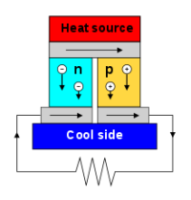Semiconductors and Heat: A Comparative Study on Thermal Conductivity
Thermal conductivity, a measure of a material’s ability to transfer heat, plays a vital role in the functionality and efficiency of electronic devices. The rate at which heat is conducted away from semiconductor devices such as transistors and diodes can significantly affect their performance and lifespan. In this article, we compare thermal conductivity among some common semiconductor materials.

Defining Thermal Conductivity in Semiconductors
Thermal conductivity is fundamentally determined by lattice vibrations or phonons in a solid. In semiconductors, both electrons and phonons contribute to heat transfer. However, the phonon contribution usually dominates because of their direct interaction with lattice vibrations. Hence, understanding phonon properties is crucial in assessing a semiconductor’s thermal conductivity.

Silicon: The Ubiquitous Semiconductor
Silicon, widely used in computer chips and transistors, has a moderate thermal conductivity of around 150 W/m.K at room temperature. Its reasonably high thermal conductivity helps dissipate the heat generated in electronic devices, reducing the risk of overheating and device failure.
Boron Arsenide: The Unconventional Challenger
A recent theoretical and experimental study on Boron Arsenide (BAs) has shown this semiconductor to possess exceptionally high thermal conductivity, potentially even surpassing that of some metals. With a thermal conductivity as high as 1300 W/m.K, BAs can serve as an efficient heat sink, paving the way for more reliable and robust electronics.
Silicon Carbide: The High-Temperature Star
Silicon Carbide (SiC) stands out with its high thermal conductivity and excellent high-temperature stability. Its thermal conductivity can reach up to 490 W/m.K, making SiC an excellent material for high-temperature applications such as power electronics, aerospace engineering, and heat management systems.
Gallium Nitride: The Solid Performer
Gallium Nitride (GaN), a wide bandgap semiconductor, exhibits relatively high thermal conductivity of about 130-160 W/m.K. Its thermal properties combined with superior electrical characteristics make GaN a suitable candidate for high-power and high-frequency electronic devices.
Low Thermal Conductivity Semiconductors and Thermoelectrics
Certain semiconductors, such as alloys and composites, exhibit low thermal conductivity, which makes them ideal for thermoelectric applications. These materials convert heat flux into electric voltage, providing a sustainable power source for small electronic devices.
Factors Influencing Thermal Conductivity
Thermal conductivity in semiconductors is influenced by several factors, including crystal structure, phonon-electron scattering, phonon-phonon scattering, and alloy scattering. Additionally, heat flow can be anisotropic, meaning it varies depending on the direction of heat flow through the crystal lattice.
Conclusion
Understanding thermal conductivity in semiconductors is pivotal for efficient thermal management in electronic devices. As technology pushes towards faster and smaller devices, the heat produced becomes a critical concern. The quest for materials with tailored thermal properties is thus an ongoing scientific adventure, driving the continual evolution of the electronics landscape.




Comments are closed.